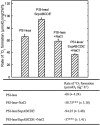The stress-induced SCP/HLIP family of small light-harvesting-like proteins (ScpABCDE) protects Photosystem II from photoinhibitory damages in the cyanobacterium Synechocystis sp. PCC 6803
- PMID: 28795265
- PMCID: PMC5783992
- DOI: 10.1007/s11120-017-0426-3
The stress-induced SCP/HLIP family of small light-harvesting-like proteins (ScpABCDE) protects Photosystem II from photoinhibitory damages in the cyanobacterium Synechocystis sp. PCC 6803
Abstract
Small CAB-like proteins (SCPs) are single-helix light-harvesting-like proteins found in all organisms performing oxygenic photosynthesis. We investigated the effect of growth in moderate salt stress on these stress-induced proteins in the cyanobacterium Synechocystis sp. PCC 6803 depleted of Photosystem I (PSI), which expresses SCPs constitutively, and compared these cells with a PSI-less/ScpABCDE- mutant. SCPs, by stabilizing chlorophyll-binding proteins and Photosystem II (PSII) assembly, protect PSII from photoinhibitory damages, and in their absence electrons accumulate and will lead to ROS formation. The presence of 0.2 M NaCl in the growth medium increased the respiratory activity and other PSII electron sinks in the PSI-less/ScpABCDE- strain. We postulate that this salt-induced effect consumes the excess of PSII-generated electrons, reduces the pressure of the electron transport chain, and thereby prevents 1O2 production.
Keywords: Photosystem II photoinhibition; Salt stress; Singlet oxygen; Small CAB-like proteins (SCPs); Terminal oxidases.
Figures






Similar articles
-
Small CAB-like proteins prevent formation of singlet oxygen in the damaged photosystem II complex of the cyanobacterium Synechocystis sp. PCC 6803.Plant Cell Environ. 2012 Apr;35(4):806-18. doi: 10.1111/j.1365-3040.2011.02454.x. Epub 2011 Dec 13. Plant Cell Environ. 2012. PMID: 22070528
-
Deletion of the gene family of small chlorophyll-binding proteins (ScpABCDE) offsets C/N homeostasis in Synechocystis PCC 6803.Biochim Biophys Acta. 2016 Apr;1857(4):396-407. doi: 10.1016/j.bbabio.2015.11.011. Epub 2015 Dec 2. Biochim Biophys Acta. 2016. PMID: 26646103
-
Small Cab-like proteins retard degradation of photosystem II-associated chlorophyll in Synechocystis sp. PCC 6803: kinetic analysis of pigment labeling with 15N and 13C.J Biol Chem. 2007 Dec 28;282(52):37660-8. doi: 10.1074/jbc.M707133200. Epub 2007 Oct 30. J Biol Chem. 2007. PMID: 17971445
-
On the interface of light-harvesting antenna complexes and reaction centers in oxygenic photosynthesis.Biochim Biophys Acta Bioenerg. 2019 Nov 1;1860(11):148079. doi: 10.1016/j.bbabio.2019.148079. Epub 2019 Sep 10. Biochim Biophys Acta Bioenerg. 2019. PMID: 31518567 Review.
-
Recent advances in understanding the assembly and repair of photosystem II.Ann Bot. 2010 Jul;106(1):1-16. doi: 10.1093/aob/mcq059. Epub 2010 Mar 25. Ann Bot. 2010. PMID: 20338950 Free PMC article. Review.
Cited by
-
Structural insights into cyanobacterial photosystem II intermediates associated with Psb28 and Tsl0063.Nat Plants. 2021 Aug;7(8):1132-1142. doi: 10.1038/s41477-021-00961-7. Epub 2021 Jul 5. Nat Plants. 2021. PMID: 34226692
-
Coevolution of tandemly repeated hlips and RpaB-like transcriptional factor confers desiccation tolerance to subaerial Nostoc species.Proc Natl Acad Sci U S A. 2022 Oct 18;119(42):e2211244119. doi: 10.1073/pnas.2211244119. Epub 2022 Oct 10. Proc Natl Acad Sci U S A. 2022. PMID: 36215485 Free PMC article.
-
The terminal enzymes of (bacterio)chlorophyll biosynthesis.R Soc Open Sci. 2022 May 4;9(5):211903. doi: 10.1098/rsos.211903. eCollection 2022 May. R Soc Open Sci. 2022. PMID: 35573041 Free PMC article. Review.
-
The Role of Pseudo-Orthocaspase (SyOC) of Synechocystis sp. PCC 6803 in Attenuating the Effect of Oxidative Stress.Front Microbiol. 2021 Feb 4;12:634366. doi: 10.3389/fmicb.2021.634366. eCollection 2021. Front Microbiol. 2021. PMID: 33613507 Free PMC article.
-
Here comes the sun: How optimization of photosynthetic light reactions can boost crop yields.J Integr Plant Biol. 2022 Feb;64(2):564-591. doi: 10.1111/jipb.13206. J Integr Plant Biol. 2022. PMID: 34962073 Free PMC article. Review.
References
-
- Beale SI. Enzymes of chlorophyll biosynthesis. Photosynth Res. 1999;60:43–73. doi: 10.1023/A:1006297731456. - DOI
MeSH terms
Substances
LinkOut - more resources
Full Text Sources
Other Literature Sources

